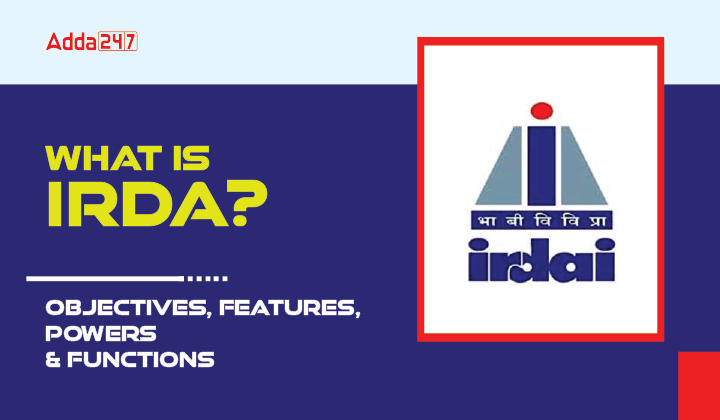Table of Contents
The IRDA or Insurance Regulatory and Development Authority came into being in 1999 after the Government of India felt the necessity to bring the insurance industry to par with the structural changes that were taking place in the financial sector. Hence, the IRDA was formed to bring in a higher degree of regulation and control in the insurance industry. In this article, we will discuss the topic of IRDA in detail.
IRDA Overview
India saw the advent of the insurance business with the establishment of Oriental Life Insurance Company in Calcutta. Ever since various insurance companies came into being, however, after India’s independence, the Government of India nationalized all the insurance companies to curb unfair trade practices.
After Liberalization was introduced in India in 1990, the “Malhotra Committee” was formed to examine the structure of the Insurance Industry and recommend changes to make it more efficient and competitive. Based on the recommendations of the “Malhotra Committee”, IRDA (Insurance Regulatory and Development Authority) was formed in 1999 after going through various transformations. The IRDA was incorporated as a statutory body in April 2000.
What is IRDA?
The IRDA (Insurance Regulatory and Development Authority) is a statutory body meant to regulate, promote and ensure the orderly growth of insurance and reinsurance business in India. The IRDA Act, of 1999 also paves the way for opening up of the insurance sector to private Indian Companies, LIC and GIC will no longer have monopolies and they will have to work under the directions of the IRDA and compete with other companies that may be set up in private sector.
Objective of IRDA
The basic objective and the aim of IRDA, 2000 is “Insurance for All by 2047” which means that every citizen shall have required life, health and property insurance coverage and every organisation is supported by appropriate insurance solutions.
Features of IRDA
The salient features of the IRDA Act (1999) are as follows;
- The IRDA Act (1999) marks the opening of India’s insurance sector to private entities. The Act’s second and third schedules outline the removal of existing corporations or companies that engage in life and non-life insurance business in India.
- An Indian insurance company is defined as a company registered under the Companies Act, of 1956, where foreign equity does not exceed 26% of the total equity shareholding, including that of NRIs, FIls, and OCBs.
- After the ten-year period, excess equity above the 26% limit will be divested according to a phased program outlined by IRDA. The Central Government has the authority to extend the ten-year period on a case-by-case basis and set higher ceilings for Indian promoter shareholding.
- Foreign promoters are subject to a maximum operational limit of 26% equity and cannot hold equity beyond this threshold at any stage.
- The Act grants statutory status to the Interim Insurance Regulatory Authority (IRA), which was established by the Central Government through a Resolution in January 1996.
- All the powers currently exercised by the Controller of Insurance (Col) under the Insurance Act, 1938, will be transferred to IRDA.
- The IRDA Act also allows for the appointment of a Controller of Insurance by the Central Government when the Regulatory Authority is superseded.
- The minimum required paid-up equity capital is Rs. 100 crore for both life and general insurance and Rs. 200 crore for reinsurance.
- The solvency margin, which represents the surplus of assets over liabilities, is mandated to be at least Rs. 50 crore for life and general insurance and Rs. 100 crore for reinsurance in each case.
- Insurance companies are required to deposit Rs. 10 crore as a security deposit before commencing operations.
- In the non-life insurance sector, preference is given to companies that offer health insurance.
- Safeguards for policyholders’ funds include a prohibition on investing these funds outside India and adherence to IRDA policy guidelines for investments, including those in social and infrastructure projects.
- Every insurer must offer life insurance or general insurance policies, including crop insurance, to individuals in rural areas, workers in the unorganized or informal sector, economically vulnerable or disadvantaged groups, and other categories specified by IRDA regulations.
- Failure to meet these social obligations may result in a Rs. 25 lakh fine, and persistent non-compliance could lead to license cancellation.
Functions of IRA
The Principal Functions of IRDA are suggested as follows:
- One of its key roles is to establish capital adequacy and solvency margin requirements, as well as other prudent standards for entities engaged in insurance activities.
- Examine, in the light of the prescribed criteria, applications for grant of registration for transacting insurance business and to grant such registration where appropriate.
- In the interest of consumer protection, set standards for insurance products. There should be a system of “file and use’ for insurance products subject to the power of the IRA to modify the rates, terms and conditions thereof within a prescribed time limit.
- Ensure compliance with the prescribed ceiling for management expenses of insurance and agency commissions.
- Monitor the performance and quality of reinsurance ceded and accepted.
- Ensuring the proper maintenance of adequate technical reserves by the insurers.
- Review the insurer’s asset distribution and management and particularly monitor compliance with prescribed prudential norms and patterns of investment.
- Ensure high standards of accounting and transparency of the balance sheet of insurance companies and scrutinize and accept annual accounts, valuation reports and solvency margin statements.
- Detect badly managed unhealthy or failing insurers and take suitable corrective action, including the appointment of administrators to temporarily manage such companies and where warranted, cancellation of registration.
- Where necessary to act as a ‘dispute resolution forum for consumer grievances.
- Create and release an annual report detailing the condition of the insurance sector.
Powers of IRDA
The IRDA has been given wide-ranging powers in the matter of promoting and regulating the orderly growth of business and exercising control over agents and other intermediaries. The following are some of the powers of IRDA.
- Granting permission for the establishment of new Insurance Companies.
- Protecting the interests of policyholders in all matters.
- IRDA specifies the qualifications, code of conduct and training required for insurance agents and other intermediaries.
- Promoting efficiency in the conduct of the insurance business.
- Encouraging and overseeing professional associations which are connected with the insurance and reinsurance industries.
- Inspection, investigation and audit of the insurers and intermediaries.
- Prescribing principles of maintenance of accounts.
- Regulating and directing the investment of funds by the Insurance Companies.
- Adjudicating the disputes between insurers and intermediaries. Specifying the minimum quantum of rural business to be procured by Life and General Insurance Companies and imposing penalties for non-compliance with provision.
Conclusion
In summary, the Insurance Regulatory and Development Authority (IRDA) plays a crucial role in the insurance industry by regulating and promoting its orderly growth. It manages registrations, sets ethical standards for industry intermediaries, exercises key powers under relevant acts, and protects policyholders’ interests, ensuring a fair and transparent insurance environment. IRDA’s multifaceted functions are essential for the industry’s integrity and policyholder security.
Download UGC NET Commerce Study Notes PDF
The direct Link to Download UGC NET Commerce Study Notes PDF has been mentioned below. Candidate can download IRDA Study Notes PDF which has been mentioned below.




 UGC NET Commerce Syllabus 2025 PDF Downl...
UGC NET Commerce Syllabus 2025 PDF Downl...
 UGC NET Teaching Aptitude Questions Answ...
UGC NET Teaching Aptitude Questions Answ...
 UGC NET Philosophy Syllabus 2025 PDF Dow...
UGC NET Philosophy Syllabus 2025 PDF Dow...




